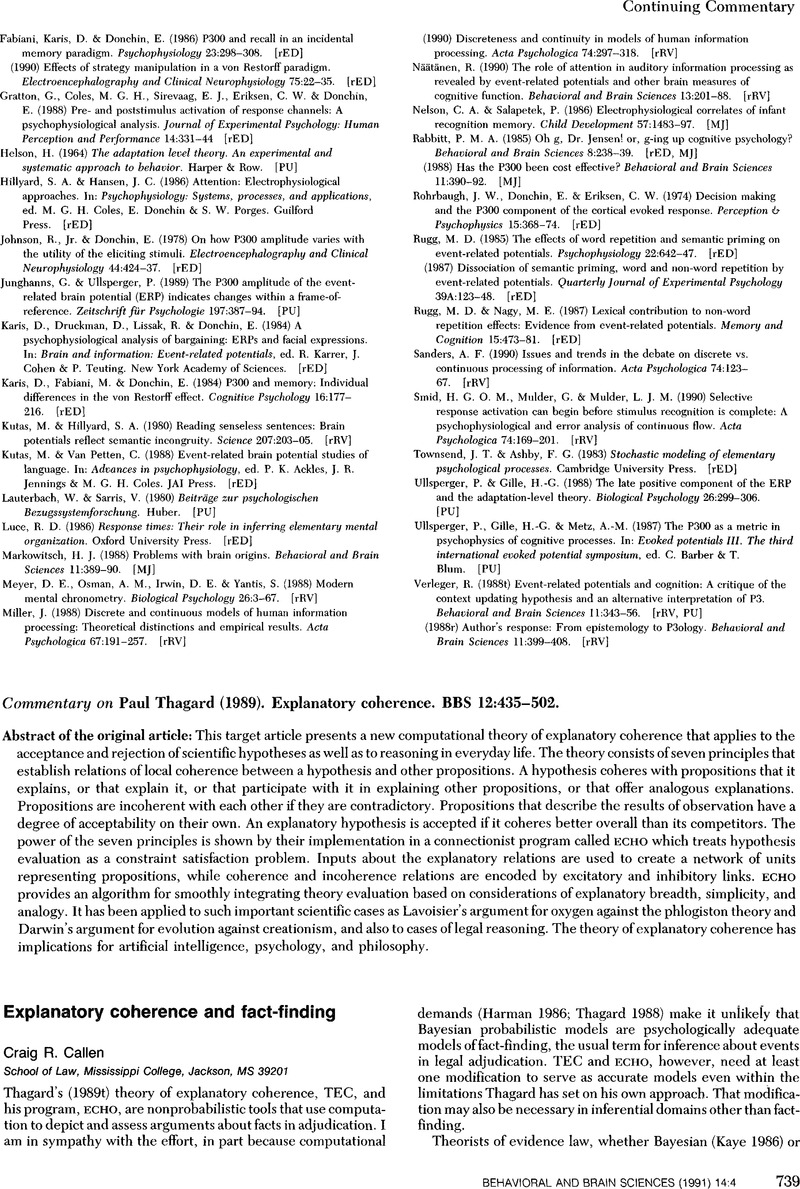No CrossRef data available.
Article contents
Defending explanatory coherence
Published online by Cambridge University Press: 19 May 2011
Abstract
An abstract is not available for this content so a preview has been provided. Please use the Get access link above for information on how to access this content.

- Type
- Author's Response
- Information
- Copyright
- Copyright © Cambridge University Press 1991
References
Allen, R. J. (1986) Reconceptualizing civil trials. Boston University Law Review 66:401–37. [CRC]Google Scholar
Brilmayer, L. (1986) Second-order evidence and Bayesian logic. Boston University Law Review 66:673–91. [CRC]Google Scholar
Cohen, L. J. (1986) The role of evidential weight in criminal proof. Boston University Law Review 66:635–49. [CRC]Google Scholar
Collins, H., (1985) Changing order: Replication and induction in scientific practice. Sage Press. [LR]Google Scholar
Dietrich, E. (1989) Is Thagard's theory of explanatory coherence the new logical positivism? Behavioral and Brain Sciences 12(3):473. [SMD]CrossRefGoogle Scholar
Feldman, J. A. & Ballard, D. H. (1982) Connectionist models and their properties. Cognitive Science 6:205–54. [NC]CrossRefGoogle Scholar
Giere, R. N. (1989) What does explanatory coherence explain? Behavioral and Brain Sciences 12(3):475. [SMD, LR]CrossRefGoogle Scholar
Gorman, M. E. (1989) Artificial epistemology? Social Studies of Science 19:374–80. [LR]CrossRefGoogle Scholar
Harman, G. (1986) Change in view: Principles of reasoning. MIT Press/Bradford Books. [CRC]Google Scholar
Hinton, G. E. & Sejnowski, T. J. (1986) Learning and relearning in Boltzmann machines. In: Parallel distributed processing: Explorations in the microstructures of cognition, vol. 1: Foundations, ed. Rumelhart, D. E. & McClelland, J. L.. MIT Press. [NC]Google Scholar
Hobbs, J. R. (1989) Are explanatory coherence and connectionist models necessary? Commentary on Thagard, Behavioral and Brain Sciences 12:476–77. [NC]CrossRefGoogle Scholar
Holmes, F. L. (1985) Lavoisier and the chemistry of life. University of Wisconsin Press. [LR]Google Scholar
Holyoak, K. & Thagard, P. (1989) Analogical mapping by constraint satisfaction. Cognitive Science 13:295–355. [PT]CrossRefGoogle Scholar
Hopfield, J. J. (1982) Neural networks and physical systems with emergent collective computational properties. Proceedings of the National Academy of Sciences of the United States of America 79:2554–58. [NC]CrossRefGoogle Scholar
Kaye, D. H. (1986) Do we need a calculus of weight to understand proof beyond a reasonable doubt? Boston University Law Review 66:657–72. [CRC]Google Scholar
Lavoisier, A.-L. (1862/1777) Oeuvres de Lavoisier, tome II 1862. Originally published 1777. [LR]Google Scholar
Lempert, R. (1986) The new evidence scholarship: Analyzing the process of proof. Boston University Law Review 66:439–77. [CRC]Google Scholar
McDermott, D. (1989) Optimization and connectionism are two different things. Commentary on Thagard, Behavioral and Brain Sciences 12:483–84. [NC, PT]CrossRefGoogle Scholar
Nowak, G. & Thagard, P. (in press a). Copernicus, Ptolemy, and explanatory coherence. In: Cognitive models of science, Minnesota studies in the philosophy of science, vol. 15, ed. Giere, R.. University of Minnesota Press. [PT]Google Scholar
(in press b) Newton, Descartes, and explanatory coherence. In: Philosophy of science, cognitive psychology and educational theory and practice, ed. Duschl, R. & Hamilton, R.. SUNY Press. [PT]Google Scholar
O'Rorke, P. (1989) Coherence and abduction. Behavioral and Brain Sciences 12(3):484. [CRC]CrossRefGoogle Scholar
Perrin, C. E. (1989) Document, text and myth: Lavoisier's crucial year revisited. British Journal of the History of Science 22:3–25. [SMD]CrossRefGoogle Scholar
Pinch, T. (1985) Toward an analysis of scientific observation: The externality and evidential context of observational reports in physics. Social Studies of Science 15:3–36. [LR]CrossRefGoogle Scholar
Roberts, L. (1991a) Setting the table. In: The structure of scientific arguments, ed. Dear, Peter. University of Pennsylvania Press. [LR] (1991b) A word and the world: The significance of naming the calorimeter. his (June). [LR]Google Scholar
Schank, P. & Ranney, M. (1991) The psychological fidelity of ECHO. Proceedings of the 13th Annual Conference of the Cognitive Science Society. Erlbaum. [PT]Google Scholar
Sintonen, M. (1989) Theory autonomy and future promise. Behavioral and Brain Sciences 12(3):488. [CRC]CrossRefGoogle Scholar
Smolensky, P. (1986) Information processing in dynamical systems: Foundations of harmony theory. In: Parallel distributed processing: Explorations in the microstructures of cognition, vol. 1: Foundations, ed. Rumelhart, D. E. & McClelland, J. L.. MIT Press. [NC]Google Scholar
Thagard, P. (1988) Computational philosophy of science. MIT Press/Bradford Books. [CRC, PT]CrossRefGoogle Scholar
(1989t) Explanatory coherence. Behavioral and Brain Sciences 12:435–502. [CRC, NC, SMD, LR, PT]CrossRefGoogle Scholar
(1989r) Extending explanatory coherence. Behavioral and Brain Sciences 12:490–99. [PT]CrossRefGoogle Scholar
(1990) The conceptual structure of the chemical revolution. Philosophy of Science 57:183–209. [LR]CrossRefGoogle Scholar
(in press b) The dinosaur debate: Explanatory coherence and the problem of competing hypotheses. In: Philosophy and AI: Essays at the interface, ed. Pollock, J. & Cummins, R.. MIT Press/Bradford Books. [PT]Google Scholar
(submitted) Probabilistic networks and explanatory coherence. Submitted to a volume on abductive inference. [PT]Google Scholar
(forthcoming) Adversarial problem solving: Modeling an opponent using explanatory coherence. Unpublished manuscript, Princeton University. [PT]Google Scholar
Thagard, P. & Nowak, G. (1990) The conceptual structure of the geological revolution. In: Computational models of discovery and theory formation, ed. Shrager, J. & Langley, P.. Morgan Kaufman. [PT]Google Scholar
Thagard, P., Holyoak, K., Nelson, G. & Gochfeld, D. (1990) Analog retrieval by constraint satisfaction. Artificial Intelligence 46:259–310. [PT]CrossRefGoogle Scholar
Wetherick, N. E. (1989) Psychology, or sociology of science? Behavioral and Brain Sciences 12(3):489. [SMD]CrossRefGoogle Scholar


